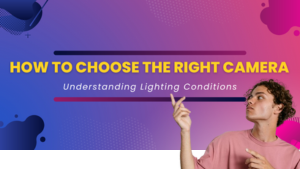
How to Choose the Right Camera: Understanding Lighting Conditions
Choosing the right camera for your specific needs can be a daunting task. With a multitude of camera parameters to consider, it’s easy to get lost in the technical jargon. However, there’s one critical factor that should be your starting point – understanding your lighting conditions. In this article, we’ll delve into the importance of comprehending your lighting environment and how it impacts your camera choice.
Understand Your Lighting Environment
Before we dive into the technical aspects of cameras, it’s essential to grasp why lighting conditions matter. The functionality of a camera is intimately tied to how it captures light, making your lighting environment a pivotal factor in camera selection.
If you’re unfamiliar with the fundamentals of how cameras work, it’s recommended to explore the basics in our companion article, “How Cameras Work.” Understanding the core principles of camera technology will provide valuable context for making informed choices regarding lighting conditions.
What is Wavelength of Light?
At the heart of understanding lighting conditions lies the concept of “wavelength.” In simple terms, wavelength refers to the distance between two successive crests or troughs of a light wave, denoted by the Greek letter lambda (λ). It’s the measure of how long one complete wave is.
Light spans a broad spectrum, from gamma rays and x-rays to ultraviolet, visible, infrared, and radio waves. However, most cameras operate within the range of ultraviolet (UV) to infrared (IR) wavelengths. Here’s a breakdown of these spectrums:

Fig: Wavelength of light across spectrum
Image source: Electromagnetic spectrum
- UV Spectrum: Wavelengths up to 400nm.
- Visible Light Spectrum: Ranges from 400nm to 800nm.
- NIR Spectrum (Near-Infrared): Extends from 800nm to 1200nm.
- IR Spectrum (Infrared): Beyond 1200nm.
The “visible spectrum” is the portion of the electromagnetic wave that’s observable by the human eye. It falls between the infrared and ultraviolet regions. The human eye can detect wavelengths from about 400 nanometers (violet) to around 700 nanometers (red). Anything beyond or below these wavelengths is invisible to our eyes due to biological limitations.
Different Types of Light and Their Wavelengths
Now that you have a grasp of light wavelengths, it’s essential to understand the different types of light and where they fall on the spectrum.
- Ultraviolet (UV): Wavelengths below 400nm.
- Visible Light: Ranges from 400nm (violet) to 700nm (red).
- Near-Infrared (NIR): Extends from 700nm to 1200nm.
- Infrared (IR): Beyond 1200nm.

These distinctions are crucial when considering your lighting conditions because different environments emit various types of light, and your camera needs to be compatible with the wavelengths present.
Camera Quantum Efficiency
Now that you’re familiar with light wavelengths, let’s delve into the concept of “Quantum Efficiency” (QE) or “Spectral Response.” This is a critical parameter when selecting a camera, as it determines the camera’s ability to convert incident photons (light particles) into electrons, which form the image.
The QE percentage is a measure of how efficiently a camera can capture and convert photons into usable data. It varies depending on the camera’s sensor technology, with high-end cameras reaching impressive QE percentages, often as high as 95%. However, QE is highly influenced by the wavelength of light being detected and the semiconductor material used in the camera’s sensor.
Much like the human eye, cameras are selective in what types of light they can detect effectively. It’s vital to ensure that your camera can convert the specific light wavelengths present in your lighting environment into clear and accurate images.
How to Determine if Your Camera is Suitable
The critical question arises: How do you know if a camera is suitable for your given lighting conditions?
The answer lies in the camera’s Quantum Efficiency chart. If you can’t find this chart, don’t worry; most camera manufacturers provide it. On this chart, you can identify which light spectrum the camera can capture efficiently and to what degree.
For instance, if your lighting conditions predominantly fall within the visible spectrum, examine the chart to see if the QE percentage peaks in that region. If your environment is rich in infrared (IR) light, focus on cameras with a higher QE percentage in the IR spectrum.
Summary
Understanding your lighting conditions is the foundation of choosing the right camera. By grasping the basics of light wavelengths, quantum efficiency, and spectral response, you’ll be better equipped to select a camera that not only meets but excels in your specific lighting environment. So, before diving into the myriad of camera features, remember that light is your camera’s canvas, and knowing it well is the first step toward capturing exceptional images.
